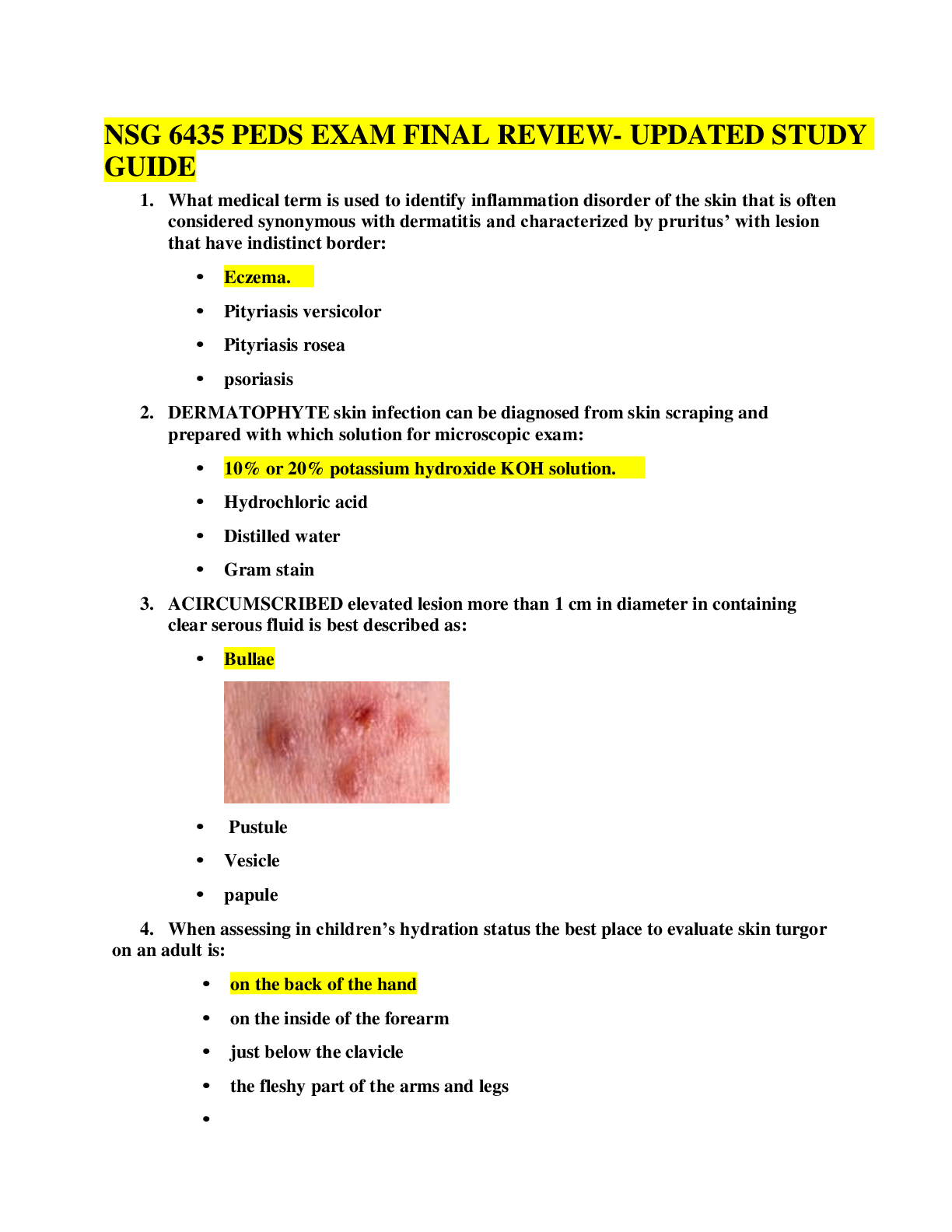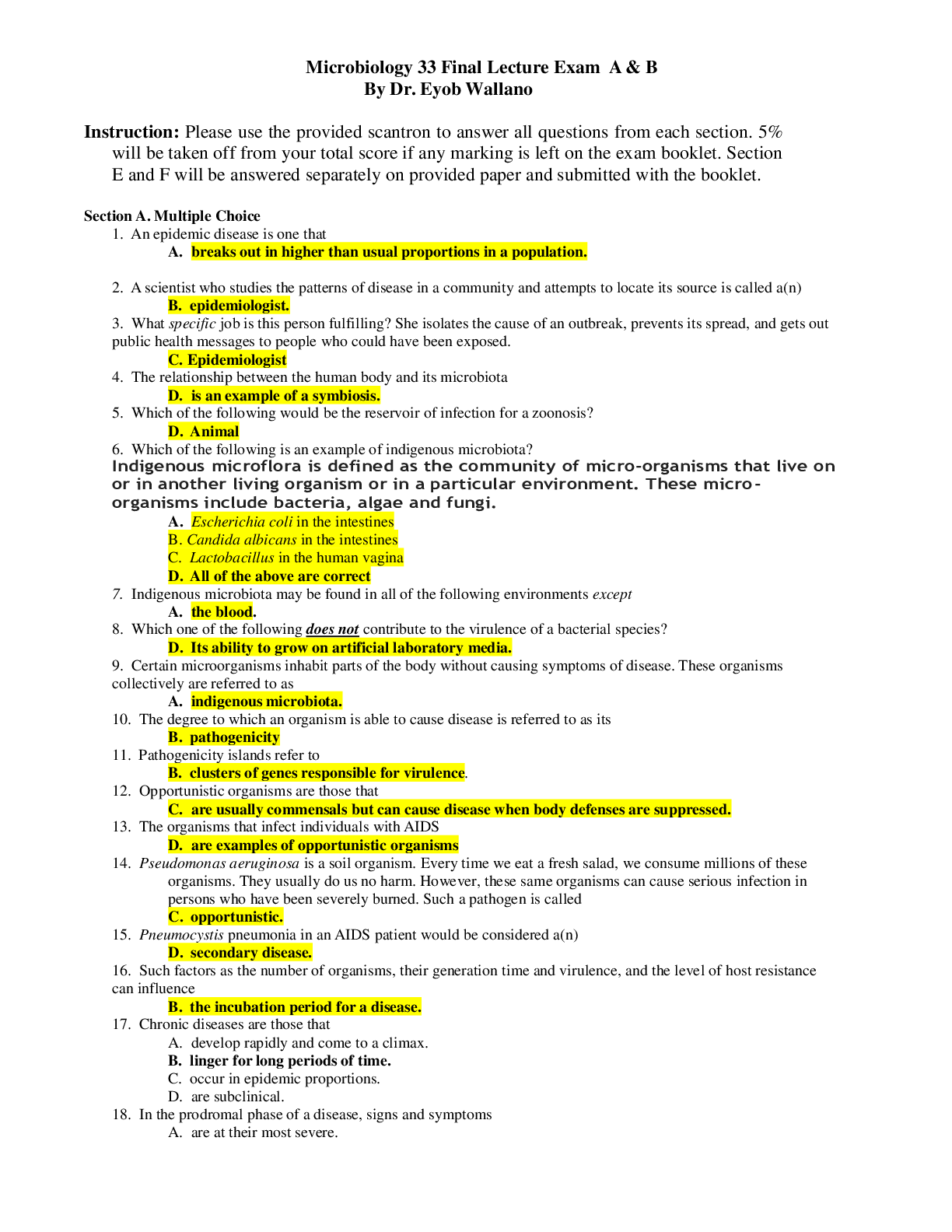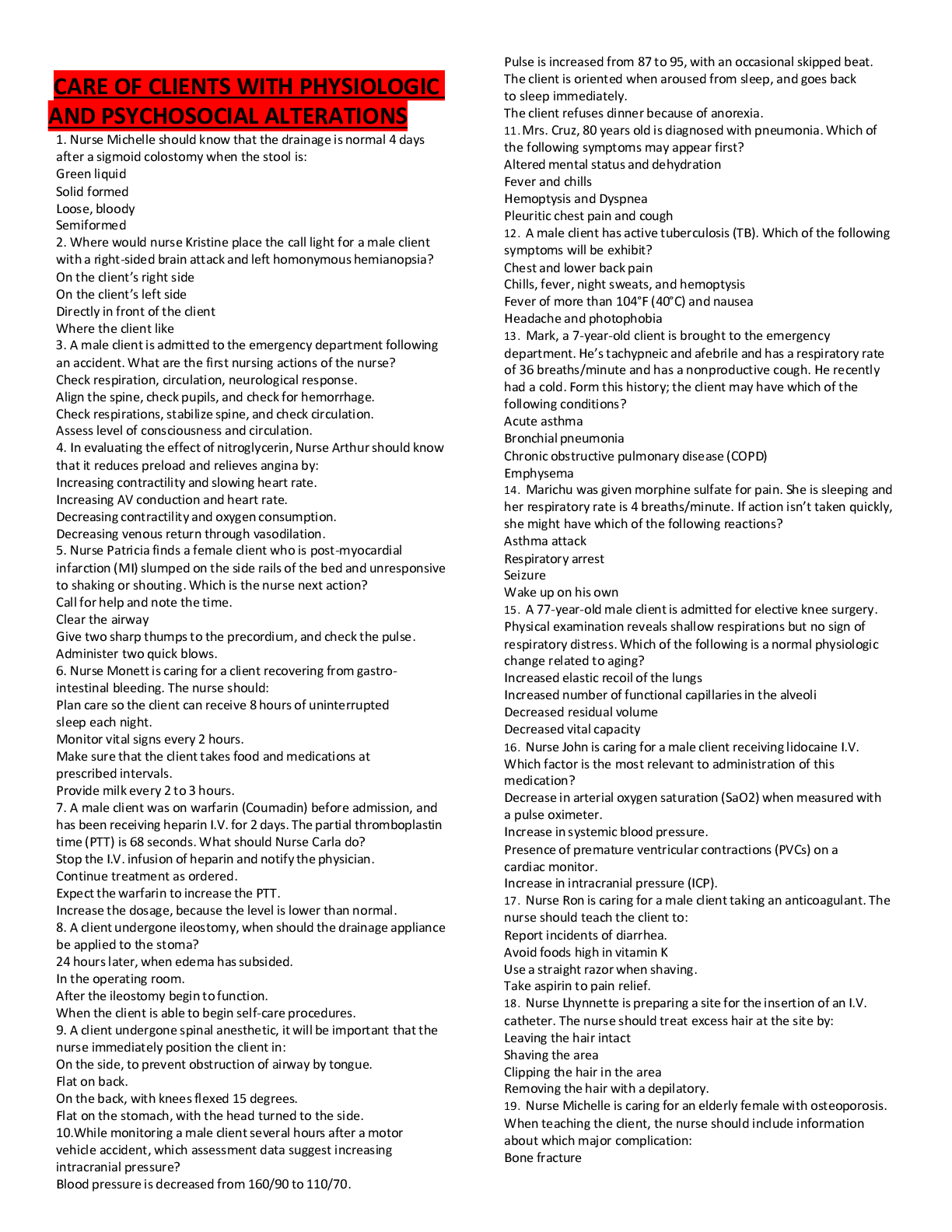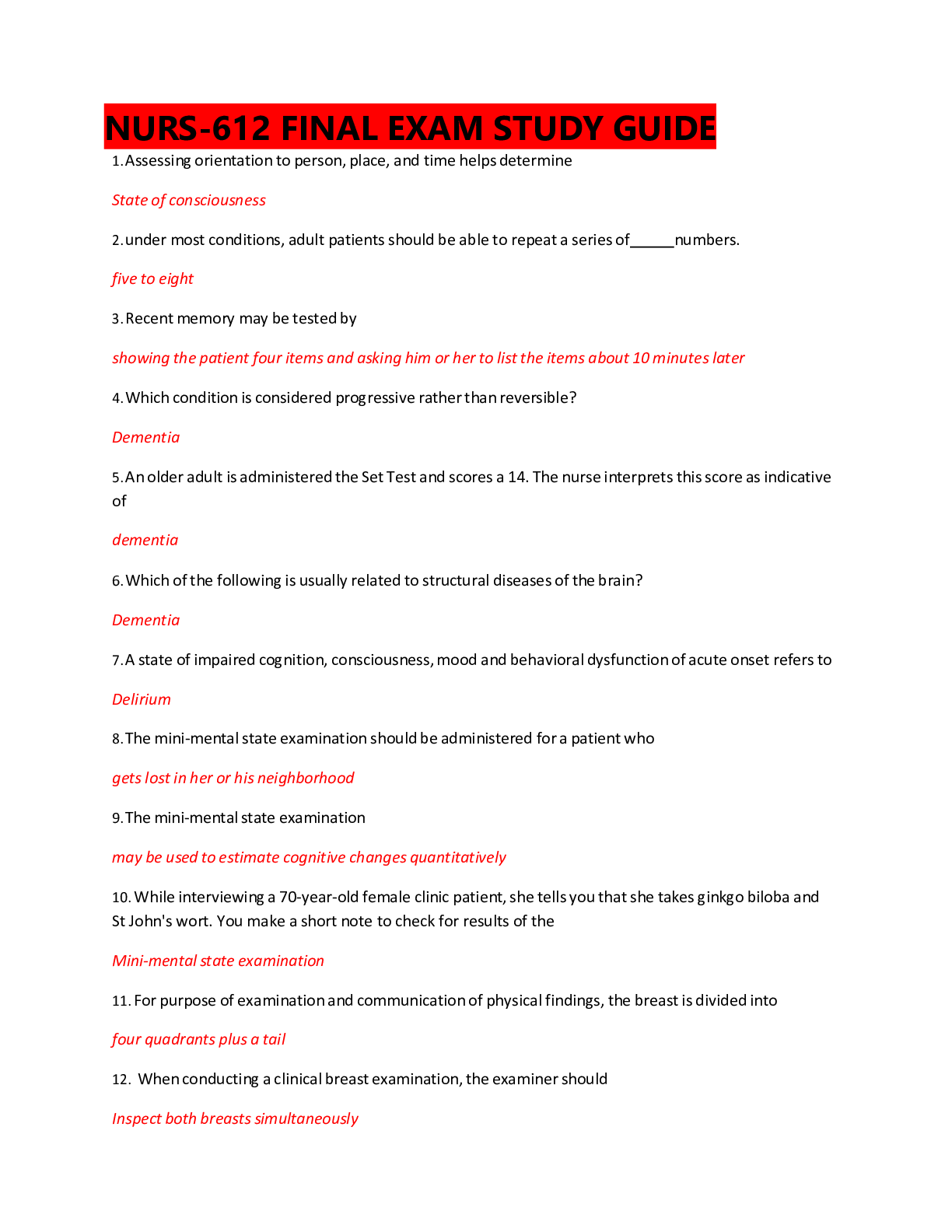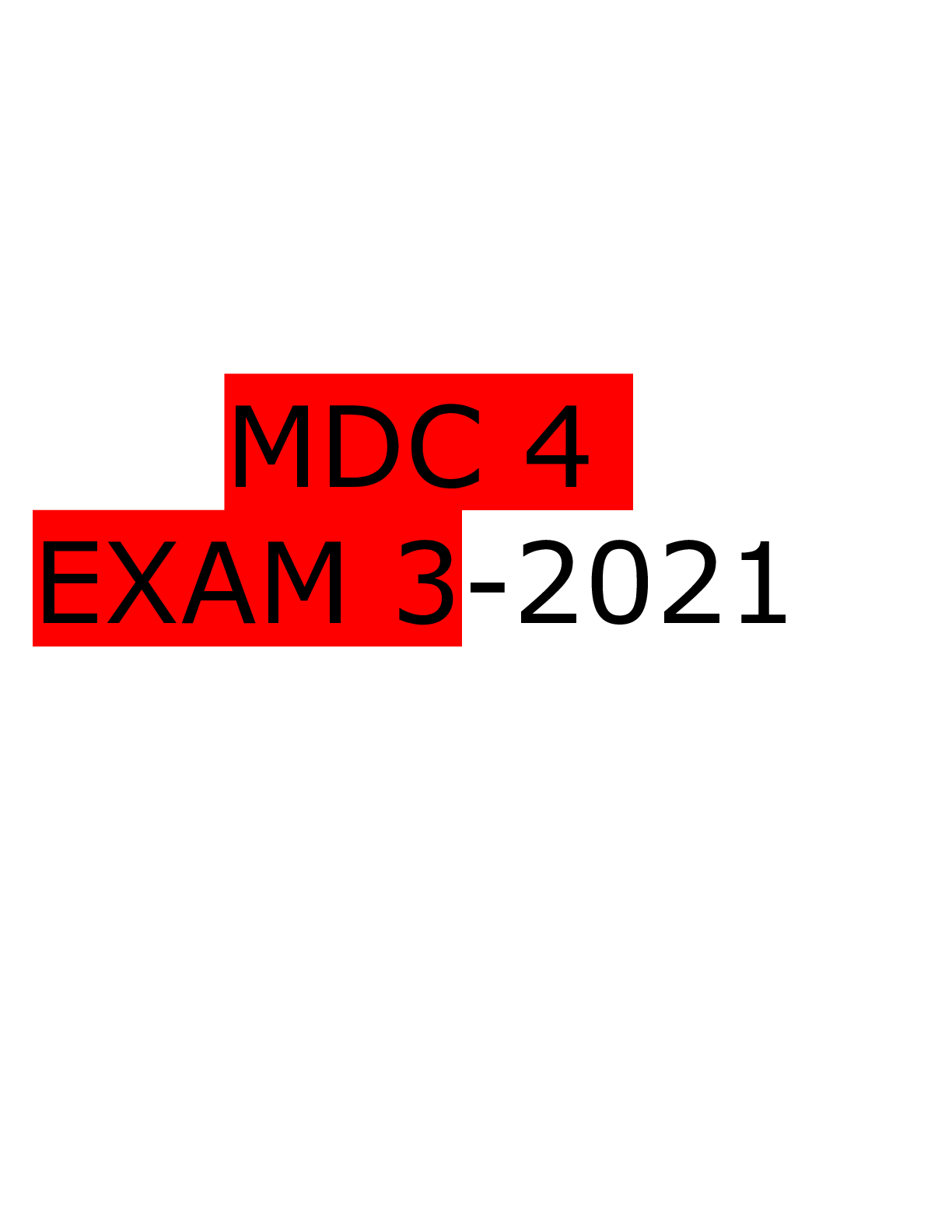*NURSING > STUDY GUIDE > HESI MEDSURG RETAKE EXAM - UDATED LATEST STUDY GUIDE (All)
HESI MEDSURG RETAKE EXAM - UDATED LATEST STUDY GUIDE
Document Content and Description Below
HESI MEDSURG RETAKE EXAM- LATEST STUDY GUIDE 1. A client with a productive cough has obtained a sputum specimen for culture as instructed. What is the best initial nursing action? Observe the colo... r, consistency, and amount of sputum. 2. A client is brought to the Emergency Department by ambulance in cardiac arrest with cardiopulmonary resuscitation (CPR) in progress. The client is intubated and is receiving 100% oxygen per self-inflating (ambu) bag. The nurse determines that the client is cyanotic, cold, and diaphoretic. Which assessment is most important for the nurse to obtain? Breath sounds over bilateral lung fields. 3. After a hospitalization of inappropriate antidiuretic hormone (SIADH), a client develops positive myelinolysis. Which intervention should the nurse implement first? Reorient client to his room. 4. A client who is admitted to the intensive care unit with syndrome of inappropriate antidiuretic hormone (SIADH) has developed osmotic demyelination. Which intervention should the nurse implement first? Evaluate swallow. 5. A male client with heart failure (HF) calls the clinic and reports that he cannot put his shoes on because they are too tight. Which additional information should the nurse obtain? Has his weight changed in the last several days? 6. An older adult woman with a long history of chronic obstructive pulmonary disease (COPD) is admitted with progressive shortness of breath and a persistent cough. She is anxious and is complaining of a dry mouth. Which intervention should the nurse implement? Apply a high-flow venturi mask. 7. Client with a history of asthma and bronchitis arrives at the clinic with shortness of breath, productive cough with thickened, tenacious mucous, and the inability to walk up a flight of stairs without experiencing breathlessness. Which action is most important for the nurse to instruct the client about self-care? Increase the daily intake of oral fluids to liquefy secretions. 8. A cardiac catheterization of a client with heart disease indicates the following blockages: 95% proximal left anterior descending (LAD), 99% proximal circumflex, and ? % proximal right coronary artery (RCA). The client later asks the nurse "what does all this mean for me?" What information should the nurse provide? Three main arteries have major blockages, with only 1 to 5% of blood flow getting through to the heart muscle. 9. A client who weighs 175 pounds is receiving IV bolus dose of heparin 80 units/kg. The heparin is available in a 2 ml vial, labeled 10,000 units/ml. How many ml should the nurse administer? (Enter numeric value only. If rounding is required, round to the nearest tenth.) 1.6 mL. 10. What information should the nurse include in the teaching plan of a client diagnosed with gastroesophageal reflux disease (GERD)? Minimize symptoms by wearing loose, comfortable clothing. 11. The nurse is caring for a client with a lower left lobe pulmonary abscess. Which position should the nurse instruct the client to maintain? Left lateral. 12. A client with cholelithiasis has a gallstone lodged in the common bile duct and is unable to eat or drink without becoming nausea and vomiting. Which finding should the nurse report to the healthcare provider? Yellow sclera. 13. The nurse is planning care for a client following an incisional cholecystectomy for cholelithiasis. Which intervention is the highest nursing priority for this client? Assisting the client to turn, cough and deep breathe every 2 hours. 14. While caring for a client with Amyotrophic Lateral Sclerosis (ALS), a nurse performs a neurological assessment every 4 hours. Which assessment finding warrants immediate intervention by the nurse? Weakened cough effort. 15. The nurse is providing preoperative education for a Jewish client scheduled to receive a xenograft graft to promote burn healing. Which information should the nurse provide this client? The xenograft is taken from nonhuman sources. 16. A male client who had colon surgery 3 days ago is anxious and requesting assistance to reposition. While the nurse is turning him, the wound dehiscences and eviscerates. The nurse moistens an available sterile dressing and places it over the wound. What intervention should the nurse implement next? Prepare the client to return to the operating room. 17. A client with carcinoma of the lung is complaining of weakness and has a serum sodium level 117 mEq/L. Which nursing problem should the nurse include in this client's plan of care? Fluid volume excess. 18. A female client enters the clinic and insists on being seen. She is weak, nervous, and reports a racing heartbeat and recent weight loss of 15 pounds. After ruling out substance withdrawal, the healthcare provider suspects hyperthyroidism and admits her for further testing. Which action should the nurse implement? Space the client's care to provide periods of rest. 19. The nurse is teaching a client with glomerulonephritis about self-care. Which dietary recommendations should the nurse encourage the client to follow? Restrict protein intake by limiting meats and other high-protein foods. 20. An overweight, young adult made who was recently diagnosed with type 2 diabetes mellitus is admitted for a hernia repair. He tells the nurse that he is feeling very weak and jittery. Which actions should the nurse implement? (Select all that apply.) • Check his fingerstick glucose level Assess his skin temperature and moisture Measure his pulse and blood pressure 21. A client with Cushing's syndrome is recovering from an elective laparoscopic procedure. Which assessment finding warrants immediate intervention by the nurse? Irregular apical pulse. 22. An adult woman with primary Raynaud phenomenon develops pallor and then cyanosis of her fingers. After warming her hands, the fingers turn red and the client reports a burning sensation. What action should the nurse take? Continue to monitor the fingers until color returns to normal. 23. A male client with muscular dystrophy fell in his home and is admitted with a right hip fracture. His right foot is cool, with palpable pedal pulses. Lungs are coarse with diminished bibasilar breath sounds. Vital signs are temperature 101F, heart rate 128 beats/minute, respirations 28 breaths/minute, and blood pressure 122/82. Which intervention is most important for the nurse to implement first? Assess lower extremity circulation. 24. The nurse is completing the preoperative assessment of a client who is scheduled for a laparoscopic cholecystectomy under general anesthesia. Which finding warrants notification of the healthcare provider prior to proceeding with the scheduled procedure? The client's blood pressure reading is 184/88 mm Hg. 25. A client who has a history of hypothyroidism was initially admitted with lethargy and confusion. Which additional finding warrants the most immediate action by the nurse? Further decline in level of consciousness. 26. Following surgical repair of the bladder, a female client is being discharged from the hospital to home with an indwelling urinary catheter. Which instruction is most important for the nurse to provide to this client? Keep the drainage bag lower than the level of the bladder. 27. Which client has the highest risk for developing skin cancer? A 65-year-old fair-skinned male who is a construction worker. 28. When caring for a client with nephrotic syndrome, which assessment is most important for the nurse to obtain? Daily weight. 29. A female client who was involved in a motor vehicle collision is admitted with a fractured left femur which is immobilized using a fracture traction splint in preparation for an open reduction internal fixation (ORIF). The nurse determines that her distal pulses are diminished in the left foot. Which interventions should the nurse implement? (Select all that apply.) Verify pedal pulses using a doppler pulse device Monitor left leg for pain, pallor, paresthesia, paralysis, pressure Evaluate the application of the splint to the left leg 30. A male client with Herpes zoster (shingles) on his thorax tells the nurse that he is having difficulty sleeping. What is the probable etiology of this problem? Pain. 31. When planning care for a client newly diagnosed with open angle glaucoma, the nurse identifies a priority nursing diagnosis of, "visual sensory/perceptual alterations." This diagnosis is based on which etiology? Decreased peripheral vision. 32. A client who is newly diagnosed with emphysema is being prepared for discharge. Which instruction is best for the nurse to provide the client to assist them with dyspnea self-management? Practice inhaling through the nose and exhaling slowly through pursed lips. 33. A client with cancer is receiving chemotherapy with a known vesicant. The client's IV has been in place for 72 hours. The nurse determines that a new IV site cannot be obtained and leaves the present IV in place. What is the greatest clinical risk related to this situation? Impaired skin integrity. 34. A postoperative client reports incisional pain. The client has two prescriptions for PRN analgesia that accompanied the client from the post anesthesia unit. Before selecting which medication to administer, which action should the nurse implement? Compare the client's pain scale rating with the prescribed dosing. 35. While assisting a female client to the toilet, client begins to have a seizure and the nurse eases her to the floor. The nurse calls for help and monitors the client until the seizing stops. Which intervention should the nurse implement first? Observe for prolonged periods of apnea. 36. A male client with diabetes mellitus (DM) is transferred from the hospital to a rehabilitation facility following treatment for a stroke with resulting right hemiplegia. He tells the nurse that his feet are always uncomfortably cool at night, preventing him from falling asleep. Which action should the nurse implement? Place warm blankets next to the client's feet. 37. During a home visit, the nurse assesses the skin of a client with eczema who reports that an exacerbation of symptoms has occurred during the last week. Which information is most useful in determining the possible cause of the symptoms? A grandson and his new dog recently visited. 38. While planning care for a client with carpal tunnel syndrome, the nurse identifies a collaborative problem of pain. what is the etiology of this problem? Compression of a nerve. 39. The nurse assesses a client being treated for Herpes Zoster (shingles). Which assessments should the nurse include when evaluating the effectiveness of treatment? (Select all that apply). Skin integrity. Functional ability. Pain scale. 40. A male client tells the clinic nurse that he is experiencing burning on urination, and assessment reveals that he had sexual intercourse four days ago with a woman he casually met. Which action should the nurse implement? Obtain a specimen of urethral drainage for culture. 41. A client with Addison's disease started taking hydrocortisone in a divided daily dose last week. It is most important for the nurse to monitor which serum laboratory value? Glucose. CONTINUED...................DOWNLOAD FOR BEST SCORES [Show More]
Last updated: 1 year ago
Preview 1 out of 47 pages
Instant download
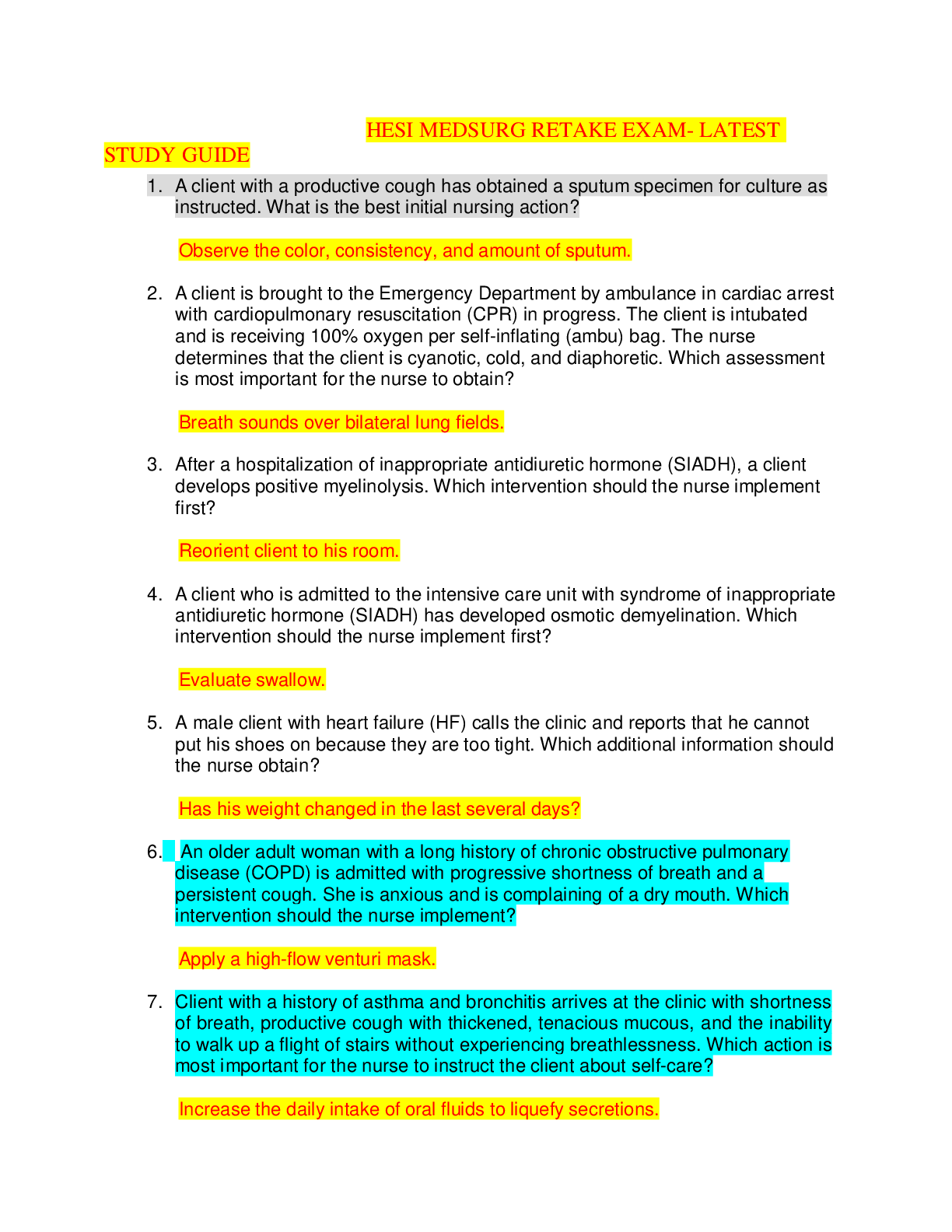
Buy this document to get the full access instantly
Instant Download Access after purchase
Add to cartInstant download
Reviews( 0 )
Document information
Connected school, study & course
About the document
Uploaded On
Mar 08, 2022
Number of pages
47
Written in
Additional information
This document has been written for:
Uploaded
Mar 08, 2022
Downloads
1
Views
142

